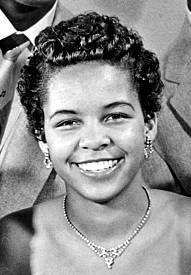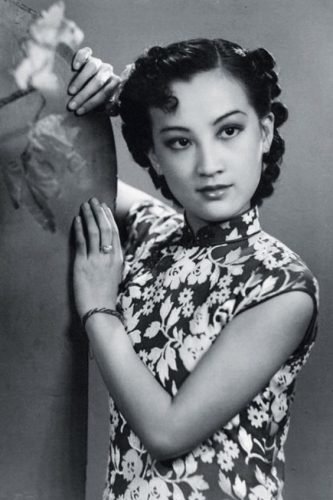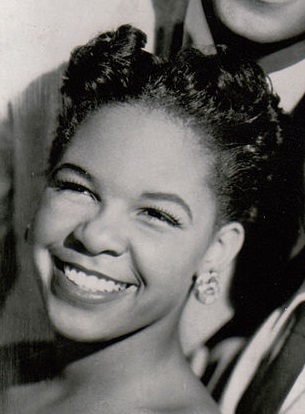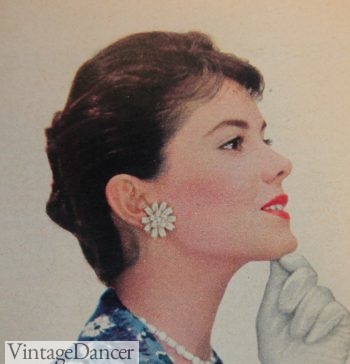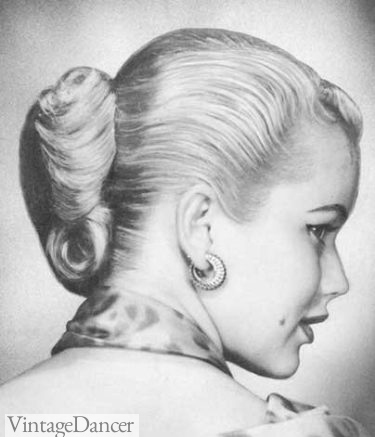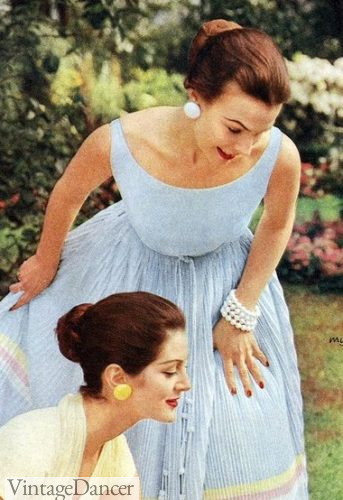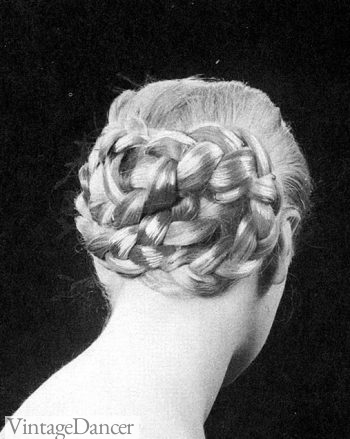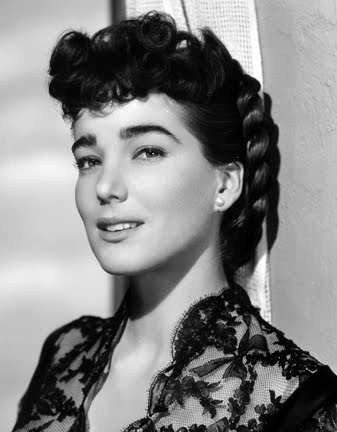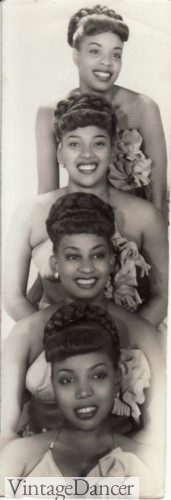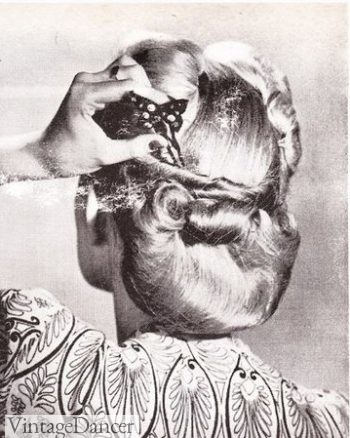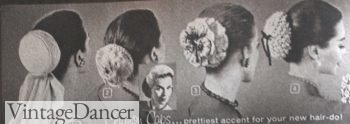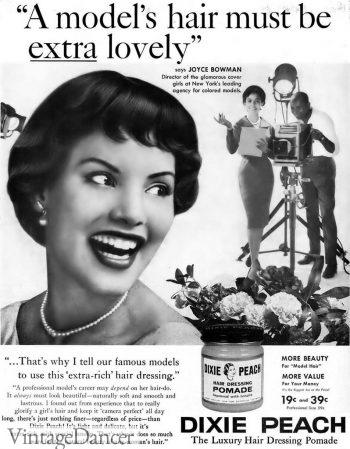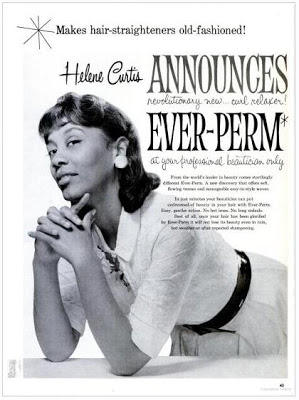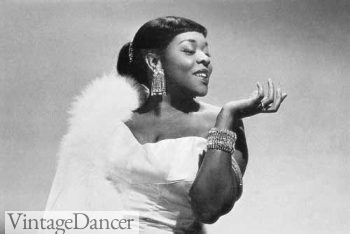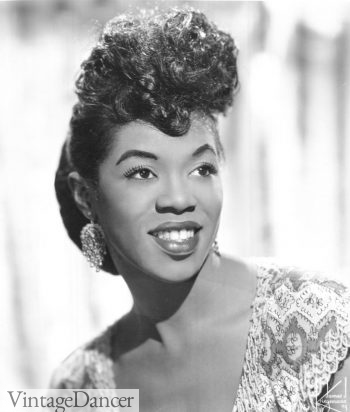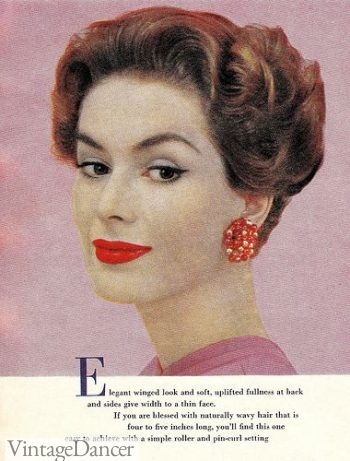
Classic 50s hairstyle
1950s hairstyles for women complimented the New Look fashion set in 1947 with hair that was shorter, looser, and required less work that than previous decades of waves, pin curls, and Victory rolls. Women still flocked to the beauty salons for weekly styling, but now the very popular short ’50s hairstyles were quicker to cut and style, giving many women the option of a home beauty routine. Shorter hairstyles needed more frequent trimming, so in the end, women spent just as much time at the salon as they did in the 1940s.
Women’s 1950s hair came in short, medium, and long styles, matching the personality of the wearer. Short for the typical housewife, medium for the young, long for Hollywood pin ups. Each cut was as unique as the woman, shaping her face and giving her a style that only belonged to her.
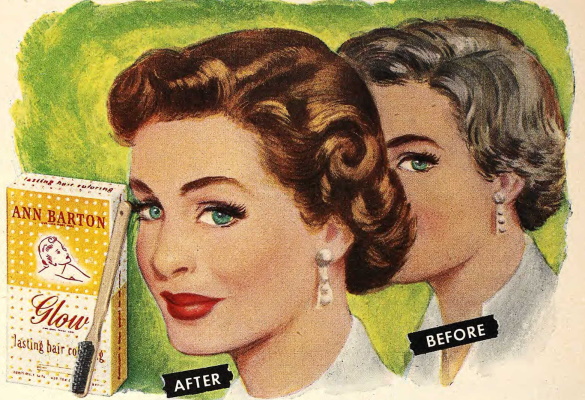
1952 short hair (Hair Dye ad)
While we will explore the most common fifties hairstyles below and offer some suggestions on achieving these same looks today, keep in mind most 50s hairstyles started with a very specific haircut and plan for pin-curling hair in exactly the same way, every day.
Our modern haircuts with layering, texturizing, waves, and natural curls can get in the way of achieving the same results. 1950s inspired hair can be achieved with practice, a few good tools, and maybe a classic haircut to work from.
Did you know we link to hundreds of 1950s style clothing? After you read this article use the 1950s menu at the top or these quick links to get started:
Dresses | Tops | Skirts | Pants | Shoes | Lingerie
1950s Hairstyles for Short Hair
Short was in! Women chopped off their shoulder length and long locks in the early ’50s in favor of the new short bob. It was a similar phenomenon to that which took place in the 1920s, when women went from long Victorian coifed hair to boyish flapper bobs. In the 1950s, it was the full swing skirts, protruding chests, and small waists that needed short cropped hairstyles to balance out the bottom heavy fashions.
Some 1950s hairstyles were as short as the flapper bob, but the ’50s bob was fuller and more dramatic like the small hats that sat on a 1950s woman’s head. Indeed, with bigger but shorter hair, hat wearing was in sharp decline. By the end of the decade, only 25% of women wore hats daily. The other 75% preferred a freshly styled bouffant.
Poodle Clip / Curly Bob
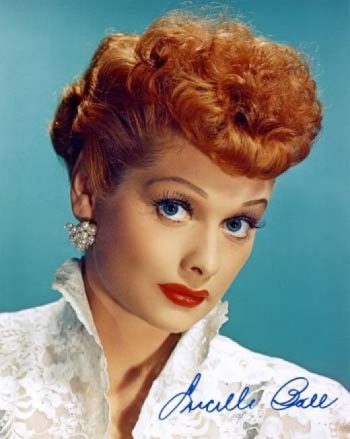
Lucile Ball’s poodle clip and dyed red hair
In 1952, salons were reporting 3 out of 5 haircuts were being cut into the Poodle clip. The trend started in the ’40s with actress Betty Grable, whose long hair was tightly curled and upswept into a poof on top of the head. Lucile Ball continued the hairstyle in the ’50s, at first gathering hair up on top, then a bit shorter with curls combed to the side, and finally shortening her hair further into an all over curly bob. Also called a bubble cut, it was worn by Jackie Kennedy on her wedding day in 1953.
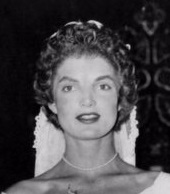
Jackie Kennedy’s “Bubble” cut
For women who chose the poodle, bubble, or curly bob, they had to use 125 curlers to set the hairstyle after each washing. Hair had to be re-cut every two weeks as well. It was the ideal cut for mature women and the perfect balance to full dresses. Stars like Denise Darcel, Peggy Ann Garner, Ann Southers, and Faye Emerson all sported the poodle clip. Straight haired women turned to the permanent wave machine to get the poodle clip to hold up to 6 weeks. The Toni or the Lift perm created the best curl.
Some critics said the poodle cut belonged on poodles, not women. The very short, all-over curl was not very feminine on most face shapes. A slightly longer curly bob was more flattering. Instead of the hair piled on top, the curls filled out the sides, tapering down to the ears or chin. Hair could be swept back, parted in the middle, or brought to one side with curls for bangs. This proved to be a longer lasting hairstyle, although Lucile Ball kept her iconic poodle for most of her career.

1950s poodle clips or curly bob hairstyles
For naturally curly and ethnic hair, the poodle or curly bob was a perfect ’50s hairstyle. Even Asian ladies opted to perm hair and create voluminous curls. Look at this easy tutorial for hairstyling with naturally curly hair. If you have long straight hair, look at this tutorial starting at minute 5.
- Zola Taylor of the Platters sports a curly poodle clip
- Zhou Xuan’s curly hair
- Zola again with natural curls
The Italian Haircut
In 1953 the short, curly, but not poodle hair was introduced as the Italian cut. It was only an inch or so longer than the poodle clip, but the curls were tousled instead of tight, with spit curls to frame the face and the neckline. “Shaggy but sculpted” was the look that most women copied for the remainder of the decade. It was easier to maintain, too. The best Italian styles looked long, but never extended below the chin, with a side part and volume on top or all around.
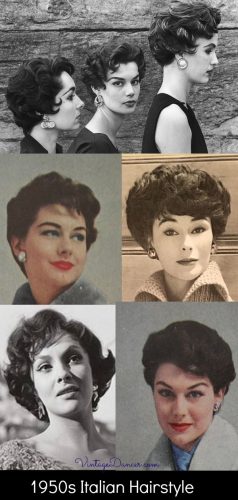
1950s Italian Hairstyles
As the decade progressed, Italian cuts blended with other styles like the bouffant to create more volume and a rounder shape. Sides also slimmed in the mid-’50s with a top-heavy design that was favored by women who preferred not to wear hats. My mom still wears this look to this day, as do many of her friends.
Soft Bob
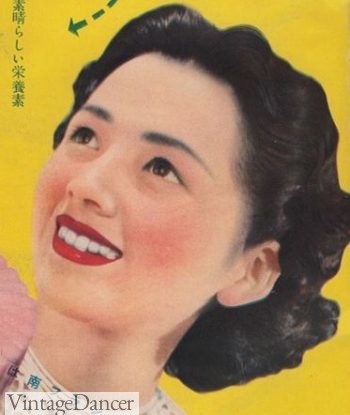
Soft curly Japanese bob
You may notice in the above pictures that the Italian cut was only worn by dark-haired ladies. Blondes, redheads, and light brunettes tried the style, but they lacked the bold facial features needed to carry off the exotic look. Instead, they adapted the Italian and the curly bob into a soft bob. It had modest volume with rolled curls all over, sometimes with a part in the center. It was shaped to frame a woman’s face to her liking. Cut close to the head with volume on the sides on top (or flat on top for hat wearing), it was a very versatile and popular hairstyle.
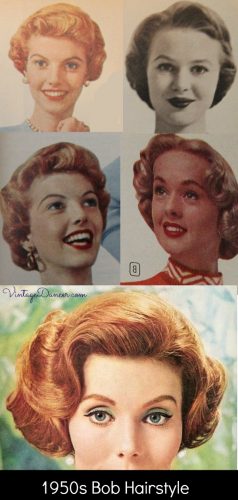
1950s bob or boobed hairstyle
Tip: Long hair can be fake bobbed by rolling/pinning the back hair under a layer of shorter strands. This works especially well for layered hair. All one length long hair can be rolled entirely under the back with softer curls or waves framing the face.
Bouffant 1950s Hairstyle
The bob and the Italian cut were both short hairstyles that were quickly outdated when the new Bouffant hairstyle developed around 1957. It would take a few years to morph into the ’60s beehive, but the beginnings were formed in the late ’50s.
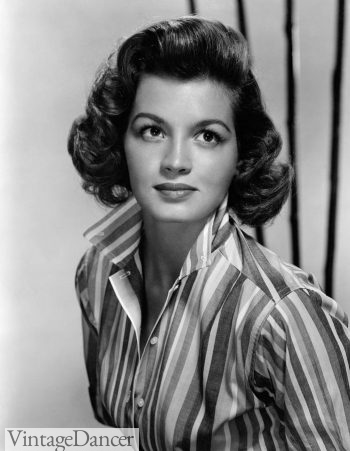
Angie Dickinson bouffant hairstyle
At first, the Italian cut was grown out with more volume shaped upward on top of the crown. Gradually, it lengthened to the chin, where the hair was swept up and back. The ’50s bouffant still had a tousled look, not as smooth as the ’60s bouffant. In shorter styles, it looked like a shaggy Italian cut. Longer hair gave more options for styling the hair upwards to new heights.
Brushing the hair backward instead of around the face was also a new concept for the ’50s. Many short hairstyles in 1959 curled hair backward, exposing the forehead. These newer high top hairstyles influenced women’s hat designs. Hats were being made wider and taller than prior years, enhancing the bouffant hairstyles. Since hat wearing was in sharp decline, millinery designers were trying anything to bring women back to them. If women wanted bouffant hair, then why not have a bouffant hat too?
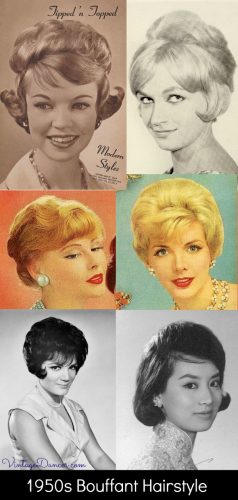
1950s Bouffants 1958-1961
To achieve the ’50s bouffant hairstyle, hair was set in large mesh rollers or empty juice cans, air dried and backcombed/ teased to create height on the top and sides. This teasing gave it the nickname the “Teasy Weasy” hairstyle. A lot of hairspray held the bouffant in place all day. Sales for hairspray, rat combs, and blow dryers surged during this time. It wasn’t uncommon to see women out shopping with hair set in rollers and wrapped in a silk scarf.
First lady Jackie Kennedy was the first famous woman to adopt the bouffant hairstyle. Her bouffant was relaxed but youthful. Stars like Connie Francis and Sophia Loren, who brought the “European bouffant” to the United States, also wore the new look.
Short Bangs
Short hair had a variety of cuts in the front. Jagged layers on the Italian, long hair brushed back on the bob, and side-swept layers for the bouffant. There was one look that went with all of the short and long hairstyles – short bangs.
First lady Mamie Eisenhower sported short bangs in the early ’50s. They were very short, tight, and waved. The top of her hair was flat, and the sides around the ears were curly fluff. It was an odd haircut (she wasn’t exactly a fashion icon for the young and trendy), but women copied it for years to come. Young girls, too, are often pictured with very short curled bangs and long or short straight hair.
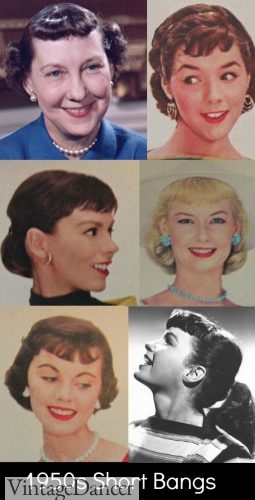
Bangs or fringe in the 50s
Short fringe bangs, about an inch above the eyebrows, with longer pieces in the center tapering shorter to the sides, was another popular shape in the mid-’50s. Curly, straight, and wavy bangs were all adopted. More about ’50s hairstyles with bangs can be found here.
Pixie Cut
Audrey Hepburn also wore short straight fringe bangs that shaped down to the ears in the Pixie haircut. The rest of the hair tapered shortly around her thin face. She debuted the Pixie the 1953 movie Roman Holiday. It perfectly matched her and Shirley McClaine’s gamin fashion style that was sweeping the country.
Boyish and young, the Pixie did not look good on most women. It was also heavily criticized by the media for being too much like a men’s haircut. The pixie had cousin hairstyles like the women’s butch cut that left the sides much shorter and the bangs evenly cut across the forehead. It took a confident woman with a long face to pull off these extra short hairstyles, but if she could do it, it gave her a very European chic / high fashion look.
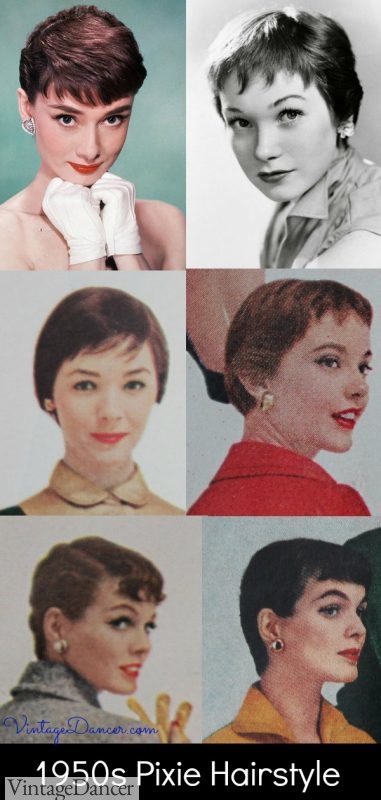
Pixie and Butch Hairstyles
The Cobra was a striking bang style cut into the shape of a V or cobra fang in case a woman wanted to look a like a Vampire. Seen in 1957, it didn’t exactly take off.
1950s Hairstyles for Medium Length Hair
The difference between short hairstyles and medium hairstyles were minimal. Most short styles looked good at a longer length, while medium styles could also be cut shorter. The choice of length was made between woman and hair stylist. The following are some styles frequently seen with shoulder-length hair. Keep in mind that curling hair will shorten it. Many chin length curly styles began with shoulder-length hair.
The Side Part
Another hairstyle for women with mostly straight hair involved a single length cut with a curved shape around the face and a deep side part. The length varied from chin to shoulder. Rolled curls faced inward toward the face or puffed out a bit in a bobbed effect.
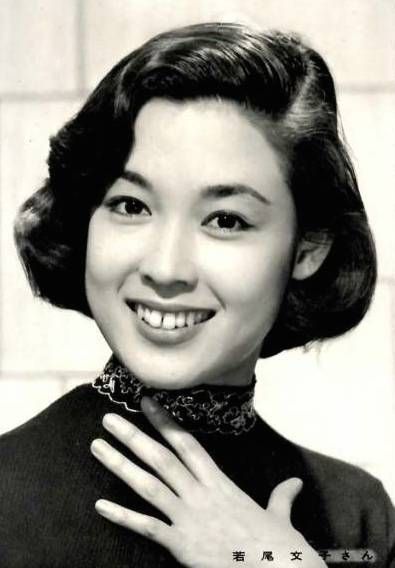
Ayako Wakao wears a deep side part
It was the deep side part that made this style unique. The side part was a youthful cut, perfect for teens and women who liked hats. The part was made 2/3 the way across the forehead and brushed over to the other side, flattening the top so that all the volume was around the chin and neck. Gene Tierney, Grace Kelly, and Mad Men‘s Betty Draper all used the side part style regularly.
A center part was less common, probably because it was used heavily in the 1940s, but some women did prefer the center part to gain a balanced look. Grace Kelly sported the center part beautifully with tight or loose curls kissing her strong jawline.
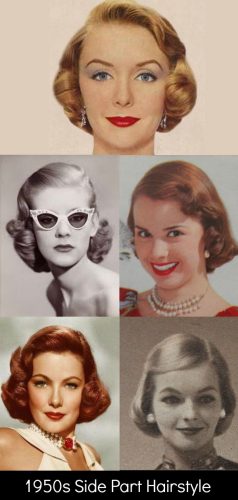
Several side parts for straight and soft curly hair
Tip. The side part is one of the easiest ’50s hairstyles you can do with most modern haircuts. I was able to transform my sister’s shoulder length, one layer hairstyle into ’50s side part glam in about 30 minutes. Most of the work involved was curling the ends under with a 2-inch barrel curling iron and adding some small curls around the top for volume. I followed this Betty Draper hair tutorial.
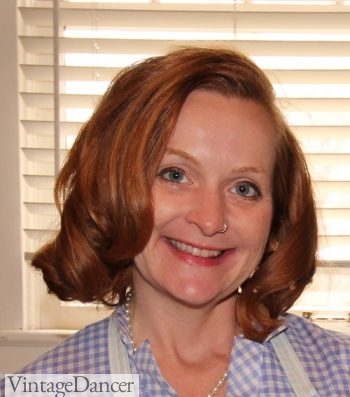
Side part modern hair turned 50s glam!
Pageboy
This popular hairstyle was often paired with the side part to create a look that was smooth and manicured. The pageboy was especially popular in the early ’50s, but remained in use until the ’60s, when it turned outward into the flip.
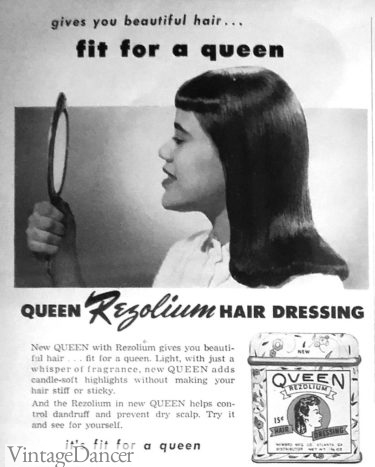
1958 pageboy long hair with short bangs
The general shape was that of straight flat hair on the top and sides, with a tightly rolled bottom and front edges facing the neck. The rolls could fall from ear to neck or be one length at the shoulder only.
Shorter chin-length versions were also popular with teens in the early ’50s. If hair was one length or bangs were long, they could be pulled and pinned to the sides or half way to the back of the head for a faux pageboy style.
In the later years, pageboys with short bangs were the more youthful look with the hair length touching the shoulders.
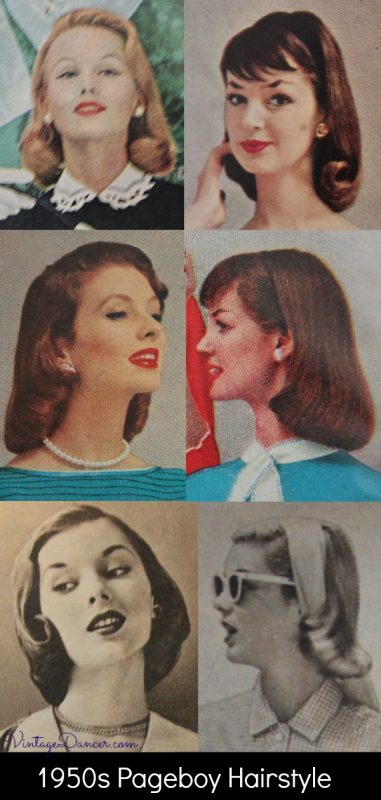
1950s pageboy hairstyles for medium length hair
Tip: Pull one side back with a hair comb or both sides with a headband or hair scarf for a youthful teenage style. If you have very long hair, you can do a reverse pageboy where you roll the hair around a scarf and tie to around the head and then pin the rolls in place, just like they did in the ’40s. Here is a tutorial for a short hair pageboy.
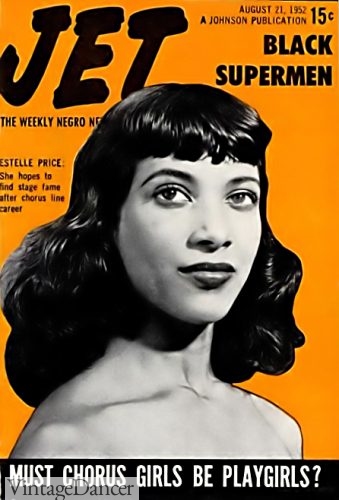
1952 pageboy hairstyle worn by Estelle Price
1950s Hairstyles for Long Hair
While long hair was rare for women in the 1950s, but it was not unheard of. Long hair was still popular with teens and young women as well as much older women who refused to follow short hair trends. However, long hair was rarely left down. After age 20, women were encouraged to take on a mature look with hair that was styled off the shoulders. Long hair was twisted, pinned, and swept up into a look that, from the front, resembled most short hairstyles.
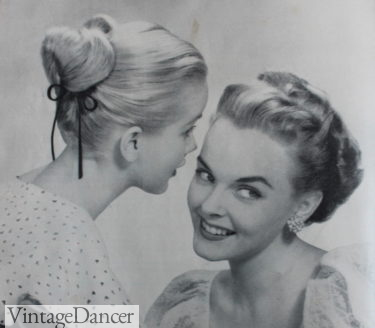
1952 long vs short hairstyles
Horse Tail, Pony Tail
The pony tail, called a horse tail in the ’50s, was favored by teens and women in the early years. Low maintenance, simple, and chic, the horse tail remains iconic with the sock hop set. Audrey Hepburn and Bridgette Bardot each sported the horse tail in movies. It was pulled up to the center of the back head and secured with a rubber band. Bangs (fringe) and curls around the face were optional. Hair for the pony tail was usually curled under first, then pulled back, giving it soft rolled edges. Elastic bands were often covered with a thin ribbon bow or pretty hair clip.
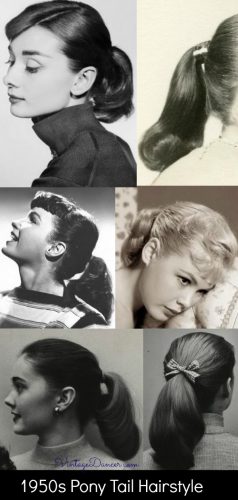
Pony Tail Hairstyles
Headbands & Scarves Hair Accessories
Hair scarves, headbands, and bandanas were often paired with pony tails, page boys, and some bobs. A wide ribbon was placed over the crown and tied at the base of the neck. Bangs were softly draped in front with and curled ends flopping forward. Headbands could be worn around short hair too, especially going into the ’60s.
In the late ’50s, it was the thin plastic headband that replaced the soft ribbon headband. A thin scarf could also be tied up on top into a big bow. Large chiffon scarves were wrapped around the head for traveling or going to the beach. They protected hairstyles from wind and looked very sophisticated while doing so.
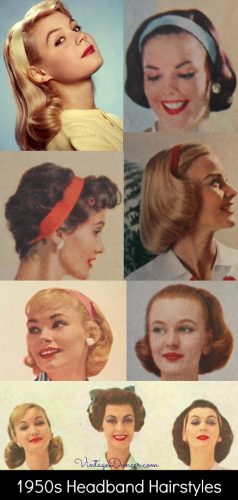
1950s Hairstyles with Headbands
Hair flowers were still in style in the first few years of the ’50s, but were generally only worn by teens. That changed in 1955, when suddenly everything floral was in vogue. Ladies wore large roses clipped to on side of a chignon for a Spanish look. Wreaths and crowns of flowers such as carnations, daisies, posies, and chrysanthemums were wrapped around the head. The fad was short-lived, but remainsa trendy ’50s hair accessory today.
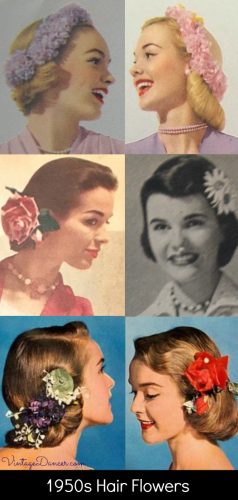
1950s Hair Flower Clips and Wreaths
The Hollywood Pin Up
Leading ladies in Hollywood, especially those that became famous in the ’30s and ’40s, could not cut their long hair. The ’40s long hairstyle favored waves with big curls on the ends. 1950s long hairstyles involved very full curls all over or a sleek top with cascading curls to one side. Deep side parts made the hair look dramatic. June Haver, Betty Grable, Jane Russel, Rita Hayworth, Ginger Rogers, Bette Davis, and Cleo More each had similar long hairstyles.
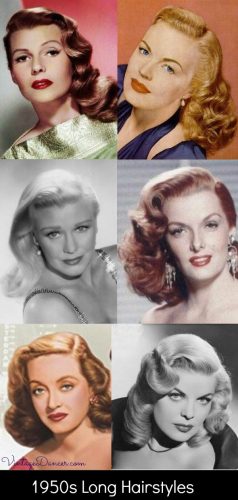
1950s Hollywood stars long curly hairstyles
Chignon and Braids
Some stars would occasionally wear long hair straight with just a soft curl or roll at the ends. Many regular women who chose to keep their long hair also preferred straight hair that they pulled back into elegant waves and chignons.
Front hair was styled into soft curls, a deep side part, or long wave, while the back was arranged in a low bun, cluster of curls, braid, or twisted ropes. Many chignons, twists, or braids were arranged up the back of the head and flattened. From the front, it was not obvious a woman had long hair. Only from the back was it seen that her hair was gathered up.
- 1950s flat bun
- 1954 chignon
- 1956 chignons for spring
- 1950s braided bun
Braids were gathered into chignon shapes or circled around the crown in a “Milkmaid” style.
- Circled braid
- Braided crowns
The Bettie Page Hairstyle
Bettie Page, a pin up icon, wore long straight wavy hair with medium length straight bangs. It was the opposite of how most classy women would dress their hair, which is exactly why it appealed to counter-culture “Beat girls” in the UK and Rebel girls in the USA. Rockabilly fans have revived this hairstyle, often combining the Bettie bangs with a pony tail and bandana.
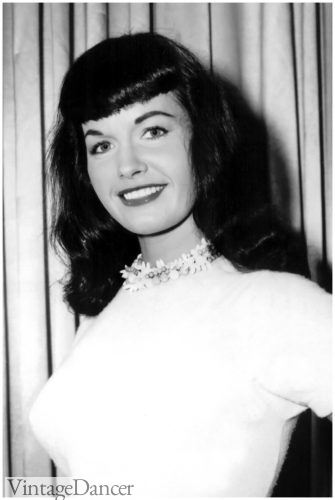
Bettie Page Bangs with long hair
50s Hairstyles Updos
For evenings and fancy afternoon events, women with long hair created a classy updo. Women with short hair usually didn’t have enough hair to make an updo so they just styled their short hair as nicely as possible. Fluffy hairstyles were often smoothed back on the sides and puffed up on top giving the illusion of an updo. The following are some of the classic 50s updo hairstyles.
French Twist
The French twist is one of my favorite quick and easy updos for long hair. Hair was pulled back after styling the front with a wave(s) or sleek top (not tight, just smooth). The hair was then twisted inward, making a roll that covered the entire back of the head. It was smooth on one side and smooth to the roll on the other. For thick hair, a double French twist was a better option. Hair was divided, then twisted into a roll from each side and joined in the middle. I followed directions in the Vintage Hairstyling book with great success.
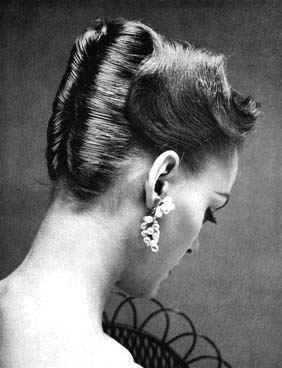
1950s Double French Twist
Chignon
“Simple but effective, the chignon braid can lend distinction to very plain and otherwise unattractive hair, it makes an ideal career-girl special.” Woman’s Weekly
The classic chignon was modernized in the 1950s. It easily moved from daywear to eveningwear, making it very versatile and fairly easy to create. Essentially, it is a bun made of hair twisted and rolled into a circle. It could also be a pony tail with the ends tucked under the middle and fanned out to the sides. Some chignons were bulky, while others were flattened and pinned. They could be centered in the back or placed lower on the nape.
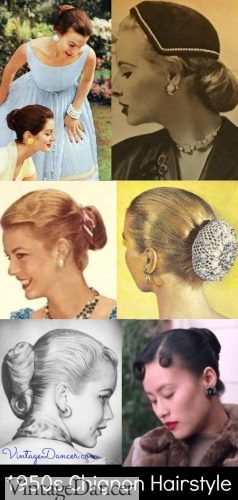
1950s chignon hairstyles
For women with short hair, a chignon bun or braid could be purchased separately and pinned to the hair. Some women who opted for the Italian cut chose to add chignon hair clips for evening looks.
“Men prefer long-hair,” commented one movie star. The chignon hair clip made it possible to have the best of both worlds.
In 1957, the chignon was so popular that hat designers made chignon caps. They were pretty covers made of knitted yarn into the shapes of flowers or chiffon pillbox hats that covered the bun. Pretty hairpins in the shapes of butterflies, birds, and flowers also decorated the tops the of the chignon.
- A flared chignon with butterfly hair pin
- 1957 Chignon caps
Upswept Updo Hairstyles
Upswept hairstyles were worn day and evening for women with medium to long hair. Taking roots from Victory rolls in the 1940s, hair was softly rolled and pinned up to the upper sides. Similar to the poodle hairstyle, piles of soft curls could circle the crown like an oversized bun, cascade down the back in a waterfall, or drape over one side of the head.
Smooth rolls, buns, and chignon also could be placed on the top of the head or to the side for an artistic high fashion look. The intention of a successful ’50s updo was always to sweep the hair off the neck and sides and bring it up to crown the head. In the early years, bangs or hair fronts were curled and pinned to match the volume of the crown, while the late ’50s preferred a smooth front or center part.
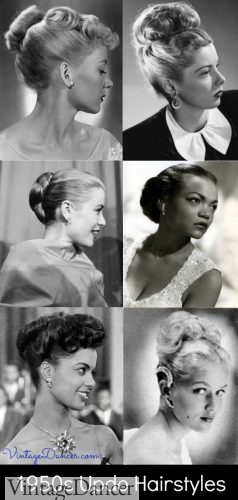
1950s updo hairstyles for long hair
Black Hairstyles
African-American hair with natural tight curls were not in style in the 1950s. There were a few exceptions, but most women continued to straighten their hair at home with a hot comb and styled it into the same looks that white women were wearing.
Curly bobs required straightening, then pin curling hair with a light comb-out for fullness. Even the short poodle cut required the straighten and curl method.
Sleek styles like the page boy, Italian, and bouffant were a bit easier to style. For black women who were able to grow hair long, updos were especially praised. Large rolls and puffs were piled high on the head in the early ’50s, or hair was sleeked back into a large chignon or bouffant in the later years.
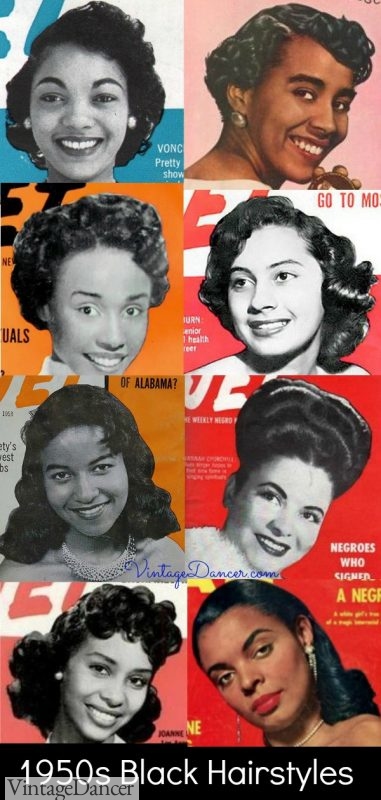
1950s African American Hairstyles
Hair Straightening was done at home or in a black beauty salon specializing in chemical straightening that began to emerge in the late 1950s. A lotion, pomade, or oil would be put through the hair and a hot metal comb with a round backside pressed down along the hair, transforming tight curls into thin shiny hair. Straightened hair was prone to the elements, and women frequently wore headscarves to protect their hair from the rain.
Hairstyling oils and pomades advertised as being “non-greasy” were marketed to the black beauty market. “It [hair] always must look beautiful -naturally soft and smooth and lustrous,” says the Dixie-Peach pomade ad below. “Natural” meant like white women’s hair. True natural African American hair was just starting to be worn in the 1950s, preparing for a revival in the ’60s. Some singers like Zora Taylor from The Platters wore her natural hair much earlier in the ’50s.
Angelique Noire, The Black Pinup has plenty of hair and style inspiration on her Instagram.
Easy natural curl hairstyle by Bobby pin Blog
- Dixie Peach Hair Pomade
- Ever-Perm hair straighter ad
Wearing wigs became a quicker and easier way to sport the latest black hairstyles without using permanent or temporary straightening. Singers Sarah Vaughan and Dinah Washington became the faces for home straighter Perma-Strate brand, but in real life, they often wore straight hair wigs styled into whatever look was in vogue that year. Other singers and actresses also wore wigs while keeping their natural hair short.
- 1954 Dinah Washington wearing a straight hair wig
- Sarah Vaughan, 1955, curly hair top with straight chignon back wig
White women also used wigs and smaller hairpieces to achieve longer hair looks, or just for perfectly styled hair without the expense of weekly salon visits. Brained buns, chignons, ponytails, rolls, and bangs were all wig piece options.
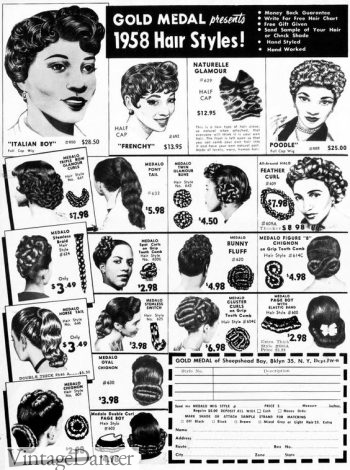
1958 wigs for sale
Colored Hair
Hair coloring was growing steadily in the 50s. In 1950, 3% of women reported using hair color. Henna was a popular colorant that was used by Lucille Ball to achieve the auburn-red color she was famous for.
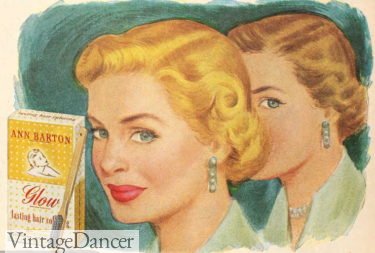
1952 blonde hair dye
Hair dyes were full of harsh chemicals that were best applied by a professional hairdresser. At home, women had the choice of hair rinses and hair creams that washed out after one or up to six washings. These added highlights, rather than dyeing the entire hair.
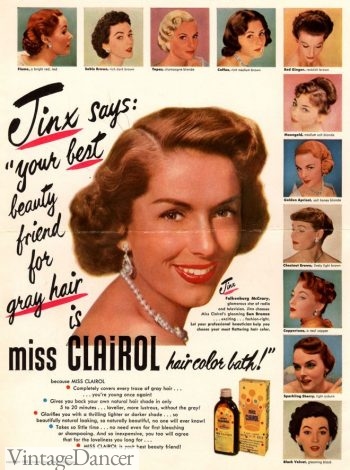
Clairol hair coloring
In the mid ’50s, there was a trend of unnatural hair colors in bright shades of blue, purple, aqua, yellow, green, white, silver and pink. Wearing a wig in one of these shades offered a complete color, but some hair designers would also tint a section of hair with a single color.
Ladies with some grey hair were encouraged to paint a wing or streak in the front with silver, adding more grey rather than detracting from it. Bleached streaks added a swoosh of platinum blonde to hair, a color made popular by bombshell Marilyn Monroe.
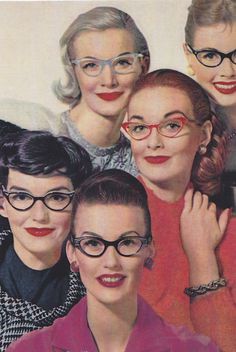
Silver grey hair color for the girl at the back, purple for the girl on the left
At home, hair paint was sold for the do it yourself stylist. Metallic gold and silver powders could be sprinkled on the hair for a dusting of sparkle, or added to small pieces as a highlight. There were also small swatches of colored fake hair that could be pinned or glued into place. Watch this video from 1955 showing chameleon hair streaks, and this one in 1956 demonstrating the two-tone colored hairstyles.
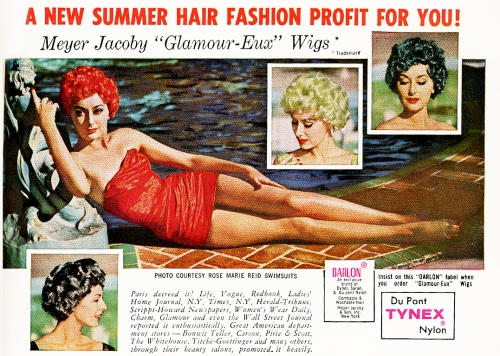
1959 colored wigs. Wow!
Advice for styling 50s hair today:
- Get a good book on how to pin curl hair. Pin curls are essential to creating vintage hairstyles. For video tutorials, look at CherryDollface.
- A styling lotion like Lotta Body, hairspray, a rat tail comb, bobby pins/Alligator clips, and a pomade to tame flyaways are your basic tools.
- Study vintage pictures of the style you want – is it realistic for your hair type?
- For accuracy, avoid “pinup” hairstyling tutorials. They are usually a combination of ’40s and ’50s style, not genuine ’50s hairstyles.
- Cut your hair? Most vintage styles use shoulder length or shorter “horseshoe” cut hairstyles. Long hair is harder to style. Once I cut my long thick hair, my world was opened to many more vintage looks!
- Add hair accessories like a headband, flower, clip or scarf. Consider a wig or hairpiece. Shop here.
That concludes our look at women’s 1950s hairstyles. Which hairstyle is your favorite?
1950s Men’s Hairstyles
Yes! We have an article for men too.
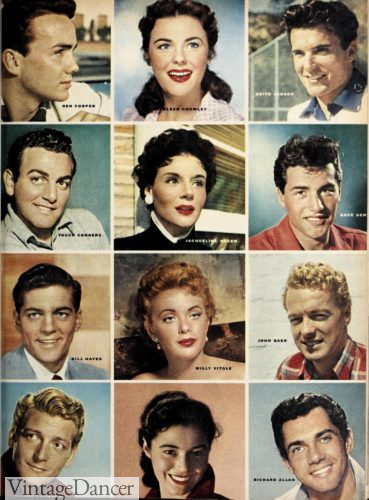
1953 men and women hairstyles of the stars
More 1950s Fashion History
- Authentic 1950s Makeup History and Tutorial
- 1950s Fashion History: Women’s Clothing
- What Did Women Wear in the 1950s? 1950s Fashion Guide
- 1950s Mature Women Fashion, Mrs. Clothing
- 1950s Teenager Fashions – Fashion Trends and Clothing Styles
- 50 Vintage Inspired Clothing Brands & Stores
Debbie Sessions has been teaching fashion history and helping people dress for vintage themed events since 2009. She has turned a hobby into VintageDancer.com with hundreds of well researched articles and hand picked links to vintage inspired clothing online. She aims to make dressing accurately (or not) an affordable option for all. Oh, and she dances too.
